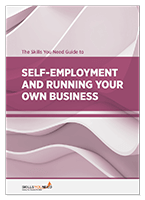How to Turn Your Skills
into a Profitable Side-Business
See also: Entrepreneurial Skills
One of the best ways to earn or increase your income is by starting a side business that allows you to turn your existing skills into profit. Many entrepreneurs tend to overlook what they can offer to a specific field because they aren’t sure how to use what they already know.
If you want to become a successful business owner, you’ll need to engage with your strengths first.

Separate Your Skills from Knowledge and from Talents
Many of us have passing knowledge on a subject because we’ve learned various things from books or movies. You may know what it requires to be a teacher, but you’ve never put this knowledge into practice. As soon as you put that knowledge into practice, you develop a skill.
On the other hand, a talent isn’t something you develop but is something you have a knack for. A talented painter picks up the skill quickly, but that doesn’t mean you can’t put the work in and be just as good. Still, developing with talent is easier and less time-consuming than without.
Skill Based: Graphic Design
You may have graphic design skills if you’ve ever used photoshop or lightroom, but visual artists and people in the tech field could also have some design experience. Although some businesses will ask for a degree, others may hire you based on your portfolio. Regardless, you need to be skillful in graphic design in order to complete client work.
Knowledge-Based: Tutoring
Getting into a tutoring career may feel intimidating to anyone who doesn’t have a degree, but there are plenty of tutor jobs online that don’t require formal education. You likely have the skill to speak English but only have a passing knowledge on how to teach it. Tutoring will require you to turn your teaching knowledge into a skill to stay successful.
How to Assess Your Talents
A talent is something that comes naturally to you.
Are you good at drawing, or are you creative in general?
Are you a hard worker, a quick learner, or both?
Do you prefer to work with your hands, or are you a proficient public speaker?
If you’re having a difficult time coming up with something, ask your family, friends, or spouse what they think you’re good at or excel in.
Next, ask yourself if that talent or skill that you possess can solve a problem. For example, if you know a second language and find that language students aren't able to grasp grammatical concepts, you could design a course that tackles that issue. Even basic chores like cooking, gardening, and ironing don’t come naturally to others, but you could use your talents to help adults with these concepts.
Combine Your Talents and Skills to Generate a Business Idea
At this point, you should be able to narrow down your specific talents and skills to create the basis of a business plan. For example, if you find that you have marketing skills and are a decent writer, you might be a great copywriter or blogger. If you are detail-oriented and can balance a checkbook, you may want to explore bookkeeping or becoming a virtual assistant.
Are my Skills Needed?
Consider the current market before deciding on your side-business because it’s challenging to create a niche when there isn’t one already. Do a quick keyword search on places like Google or WordTracker. Keyword research can help you discover what customers are struggling with and how your skills can help them solve their problems.
Can I Niche Down?
A business that’s in demand may have a lot of job opportunities, but that also means you have competition. You have to stand out to attract clients by niching down. For example, a knitter may want to niche down into a pop-culture knitter that only creates blankets with Marvel characters, or a bookkeeper may market their services to freelancers only.
Package Knowledge into Something Worthwhile
A business's number one goal is to make money, but to do that you need to understand how your product or service can maximize the value for your customers. Ask yourself why you use the services you use and what they bring into your life. For example, did an online course allow you to pursue a new business venture, or was it to learn a skill or hobby away from work?
Understanding the Value of Your Product
The value a product or service provides to a customer will also determine what your user base is willing to pay. A course that teaches its students how to make a profitable freelance writing business can charge more than a dance class because the freelancing writing course can turn competence into profit for its users. Unless your customers want to make dancing a career choice, they’re more likely to keep it as a hobby or as a way to burn off steam at the club.
However, your user base may see dancing as a form of exercise which you can then package as a weight loss alternative to other cardio exercises like running or walking. Sometimes the way you market the product can change someone's mind on the value of what you’re teaching.
Convenience vs. Time vs. Money
Let’s use the freelancing and dancing course example again. Dancing is a skill that has to be practiced with the body, whereas freelancing writing doesn’t require the same physical space. A user that wants to learn a dance may prefer to go to a studio, but they don’t have the money, time, or transportation to constantly show up to class.
Freelance writing is also something traditionally taught in a school environment but is easier to teach away from the classroom setting because it doesn’t involve physical exercise.
Your audience may think that the convenience of learning both dancing and freelance writing from home trumps what they have to pay for it. The value customers receive is equal to the benefits of the product or service minus its cost. If dance instructors are just as good in person as they are on video, you can state the product's convenience as a selling point.
Research What Others are Charging
Always look at your competition before selling a product, because you could lose a lot of money if you charge the wrong amount. This goes both ways: a cheaper product may tell your audience it isn’t worth their time, while an expensive product may be out of reach for your users.
It’s also important to provide different ways to purchase your service. Stay up to date with the latest technology and payments so you don’t unintentionally lose sales. Always include credit card, PayPal and a subscription option to provide more convenience for your customers.
Further Reading from Skills You Need
The Skills You Need Guide to Self-Employment and
Running Your Own Business
If you are thinking about running your own business, or already do so, but feel that you need some guidance, then this eBook is for you. It takes you through self-employment in easy steps, helping you to ensure that your business has more chance of success.
The Skills You Need Guide to Self-Employment and Running Your Own Business is the guide no new or aspiring entrepreneur can afford to be without!
Based on our popular self-employment and entrepreneurship content.
About the Author
Cristina Par is a content specialist with a passion for writing articles that bridge the gap between brands and their audiences. She believes that high-quality content plus the right link building strategies can turn the tables for businesses small and large.


